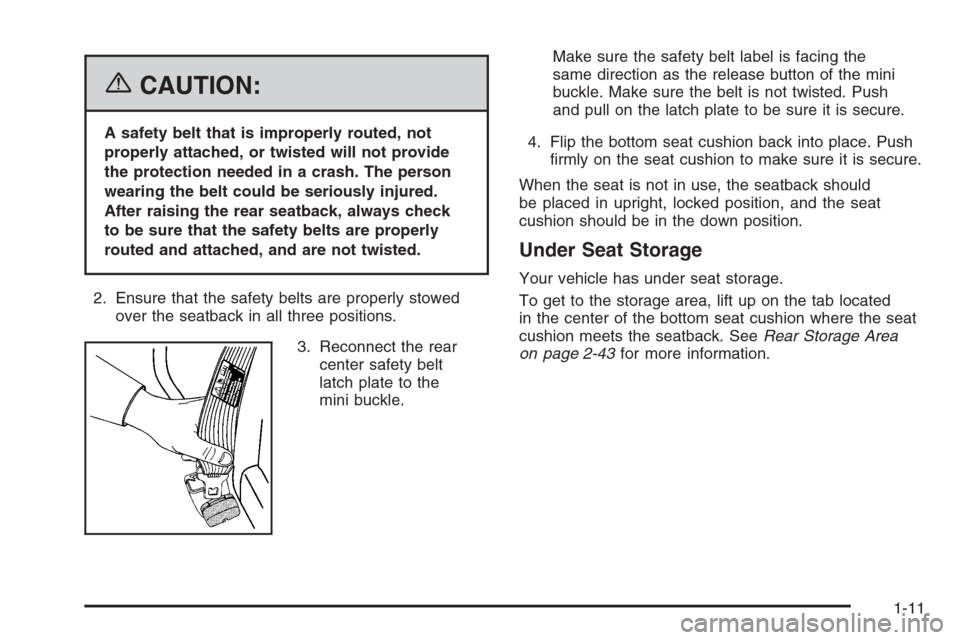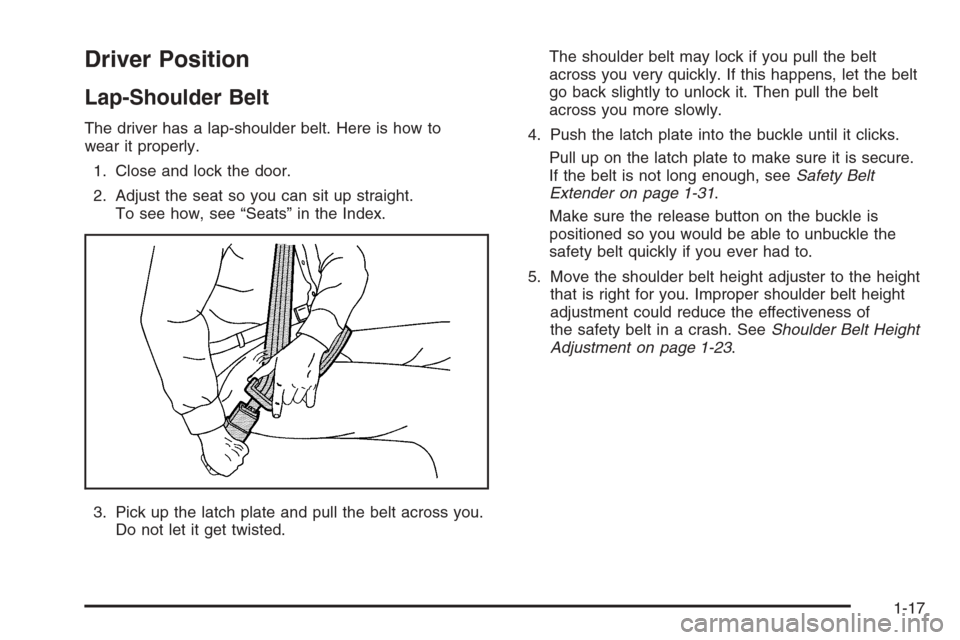Page 1 of 394

Seats and Restraint Systems........................... 1-1
Front Seats
............................................... 1-2
Rear Seats
............................................... 1-9
Safety Belts
.............................................1-12
Child Restraints
.......................................1-32
Airbag System
.........................................1-55
Restraint System Check
............................1-69
Features and Controls..................................... 2-1
Keys
........................................................ 2-2
Doors and Locks
......................................2-10
Windows
.................................................2-15
Theft-Deterrent Systems
............................2-17
Starting and Operating Your Vehicle
...........2-20
Mirrors
....................................................2-34
OnStar
®System
......................................2-36
Universal Home Remote System
................2-38
Storage Areas
.........................................2-42
Sunroof
..................................................2-44
Instrument Panel............................................. 3-1
Instrument Panel Overview
.......................... 3-4
Climate Controls
......................................3-19
Warning Lights, Gages, and Indicators
........3-24
Driver Information Center (DIC)
..................3-39
Audio System(s)
.......................................3-58Driving Your Vehicle....................................... 4-1
Your Driving, the Road, and Your Vehicle
..... 4-2
Towing
...................................................4-34
Service and Appearance Care.......................... 5-1
Service
..................................................... 5-3
Fuel
......................................................... 5-4
Checking Things Under the Hood
...............5-10
Headlamp Aiming
.....................................5-47
Bulb Replacement
....................................5-48
Windshield Wiper Blade Replacement
.........5-52
Tires
......................................................5-54
Appearance Care
.....................................5-84
Vehicle Identi�cation
.................................5-92
Electrical System
......................................5-93
Capacities and Speci�cations
.....................5-99
Maintenance Schedule..................................... 6-1
Maintenance Schedule
................................ 6-2
Customer Assistance and Information.............. 7-1
Customer Assistance and Information
........... 7-2
Reporting Safety Defects
...........................7-14
Index................................................................ 1
2006 Chevrolet Impala Owner ManualM
Page 8 of 394
Front Seats
Manual Passenger Seat
Your vehicle may have a manual passenger seat.
Lift the bar located under the front of the seat to unlock
it. Slide the seat to where you want it and release
the bar. Try to move the seat with your body to be sure
the seat is locked in place.
Six-Way Power Seats
Your vehicle may have a 6-way power driver’s or
passenger’s seat. The control is located on the outboard
side of the seat cushion. To adjust the seat, do any of
the following:
Move the seat forward or rearward by sliding the
control forward or rearward.
Raise or lower the front part of the seat cushion by
moving the front of the control up or down.
Raise or lower the rear part of the seat cushion by
moving the rear of the control up or down.
Passenger’s Seat with 6-way Power Control
and Manual Recline shown
1-2
Page 11 of 394
Reclining Seatbacks
Manual Reclining Seatbacks
{CAUTION:
You can lose control of the vehicle if you try to
adjust a manual driver’s seat while the vehicle
is moving. The sudden movement could startle
and confuse you, or make you push a pedal
when you do not want to. Adjust the driver’s
seat only when the vehicle is not moving.
{CAUTION:
If the seatback is not locked, it could move
forward in a sudden stop or crash. That could
cause injury to the person sitting there. Always
push and pull on the seatback to be sure it is
locked.The vehicle has manual recline on the front passenger’s
seat. There may be manual recline on the driver’s seat.
To recline the seatback, do the following:
1. Lift the recline lever.
2. Move the seatback to the desired position, then
release the lever to lock the seatback in place.
3. Push and pull on the seatback to make sure
it is locked.Passenger’s Seat with Manual Recline and
Power Seat Control shown
1-5
Page 12 of 394
To return the seatback to an upright position, do the
following:
1. Lift the lever fully without applying pressure to
the seatback and the seatback will return to the
upright position.
2. Push and pull on the seatback to make sure
it is locked.Power Reclining Seatback
The driver’s seat may have a power reclining seatback.
The control used to operate it is located on the
outboard side of the seat cushion rear of the horizontal
power seat control.
Press the front of the control to recline the seatback.
Press the rear of the control to raise the seatback. Driver’s Seat with Manual Lumbar, Power Seat
Control, and Power Recline shown
1-6
Page 16 of 394
2. Flip the bottom seat cushion forward by pulling up
on the tab located in the center of the seat cushion
where the seatback meets the seat cushion.
There is a tab on both rear seats.
Make sure the front seats are not reclined. If they
are, the seat cushion will not �ip forward completely.3. Lower the seatback(s)
by pulling forward on
the tab located on
the outboard side of the
seatback(s). Make
sure the front seats are
not reclined. If they
are, the rear seatbacks
will not fold down all
the way.
To return the seats to the normal position, do the
following:{CAUTION:
If the seatback is not locked, it could move
forward in a sudden stop or crash. That could
cause injury to the person sitting there. Always
push and pull on the seatback to be sure it is
locked.
1. Raise the seatback up and make sure it latches.
1-10
Page 17 of 394

{CAUTION:
A safety belt that is improperly routed, not
properly attached, or twisted will not provide
the protection needed in a crash. The person
wearing the belt could be seriously injured.
After raising the rear seatback, always check
to be sure that the safety belts are properly
routed and attached, and are not twisted.
2. Ensure that the safety belts are properly stowed
over the seatback in all three positions.
3. Reconnect the rear
center safety belt
latch plate to the
mini buckle.Make sure the safety belt label is facing the
same direction as the release button of the mini
buckle. Make sure the belt is not twisted. Push
and pull on the latch plate to be sure it is secure.
4. Flip the bottom seat cushion back into place. Push
�rmly on the seat cushion to make sure it is secure.
When the seat is not in use, the seatback should
be placed in upright, locked position, and the seat
cushion should be in the down position.
Under Seat Storage
Your vehicle has under seat storage.
To get to the storage area, lift up on the tab located
in the center of the bottom seat cushion where the seat
cushion meets the seatback. SeeRear Storage Area
on page 2-43for more information.
1-11
Page 23 of 394

Driver Position
Lap-Shoulder Belt
The driver has a lap-shoulder belt. Here is how to
wear it properly.
1. Close and lock the door.
2. Adjust the seat so you can sit up straight.
To see how, see “Seats” in the Index.
3. Pick up the latch plate and pull the belt across you.
Do not let it get twisted.The shoulder belt may lock if you pull the belt
across you very quickly. If this happens, let the belt
go back slightly to unlock it. Then pull the belt
across you more slowly.
4. Push the latch plate into the buckle until it clicks.
Pull up on the latch plate to make sure it is secure.
If the belt is not long enough, seeSafety Belt
Extender on page 1-31.
Make sure the release button on the buckle is
positioned so you would be able to unbuckle the
safety belt quickly if you ever had to.
5. Move the shoulder belt height adjuster to the height
that is right for you. Improper shoulder belt height
adjustment could reduce the effectiveness of
the safety belt in a crash. SeeShoulder Belt Height
Adjustment on page 1-23.
1-17
Page 24 of 394
6. To make the lap part tight, pull up on the
shoulder belt.
The lap part of the belt should be worn low and snug on
the hips, just touching the thighs. In a crash, this applies
force to the strong pelvic bones. And you would be less
likely to slide under the lap belt. If you slid under it, the
belt would apply force at your abdomen. This could cause
serious or even fatal injuries. The shoulder belt should go
over the shoulder and across the chest. These parts of
the body are best able to take belt restraining forces.
The safety belt locks if there is a sudden stop or crash,
or if you pull the belt very quickly out of the retractor.
1-18